
Karl "Quax" Schnörrer was a German military aviator who served in the Luftwaffe during World War II. As a fighter ace, he claimed 46 enemy aircraft shot down in 536 combat missions, eleven of which while flying the Messerschmitt Me 262 jet fighter in Defense of the Reich.

Walter Nowotny was an Austrian-born fighter ace of the Luftwaffe in World War II. He is credited with 258 aerial victories—that is, 258 aerial combat encounters resulting in the destruction of the enemy aircraft—in 442 combat missions. Nowotny achieved 255 of these victories on the Eastern Front and three while flying one of the first jet fighters, the Messerschmitt Me 262, in the Defense of the Reich. He scored most of his victories in the Focke-Wulf Fw 190, and approximately 50 in the Messerschmitt Bf 109. Nowotny scored an "ace in a day" on multiple occasions, shooting down at least five airplanes on the same day, including two occurrences of "double-ace in a day" in mid-1943.

Johannes "Macky" Steinhoff was a Luftwaffe fighter ace during World War II, German general, and NATO official. He was one of very few Luftwaffe pilots who survived to fly operationally through the whole of the war period 1939–45 until he was severely burned during a failed take-off. Steinhoff was also one of the highest-scoring pilots with 176 victories, and one of the first to fly the Messerschmitt Me 262 jet fighter in combat as a member of the Jagdverband 44 squadron led by Adolf Galland. Steinhoff was decorated with the Knight's Cross of the Iron Cross with Oak Leaves and Swords, and later received the Grand Cross of the Order of Merit of the Federal Republic of Germany and several foreign awards including the American Legion of Merit and the French Legion of Honour. He played a role in the so-called Fighter Pilots' Revolt late in the war, when several senior air force officers confronted Hermann Göring.
Heinz Wimmersal Sachsenberg was a German World War II fighter ace who served in the Luftwaffe. He was also a recipient of the Knight's Cross of the Iron Cross, the highest award in the military and paramilitary forces of Nazi Germany during World War II. Sachsenberg claimed 104 aerial victories.

Walter Krupinski was a German Luftwaffe fighter ace in World War II and a senior West German Air Force officer during the Cold War. He was one of the highest-scoring pilots in the war, credited with 197 victories in 1,100 sorties. He was called by his fellow pilots Graf Punski due to his Prussian origins. Krupinski was one of the first to fly the Messerschmitt Me 262 jet fighter in combat as a member of Jagdverband 44 led by Adolf Galland.
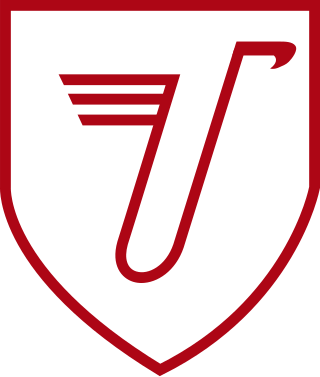
Jagdgeschwader 3 "Udet" was a Luftwaffe fighter wing of World War II. The Geschwader operated on all the German fronts in the European Theatre of World War II. It was named after Ernst Udet, an important figure in the development of the Luftwaffe, in 1942.
Jagdgeschwader 7 Nowotny was a Luftwaffe fighter wing during World War II and the first operational jet fighter unit in the world. It was created late in 1944 and served until the end of the war in May 1945.
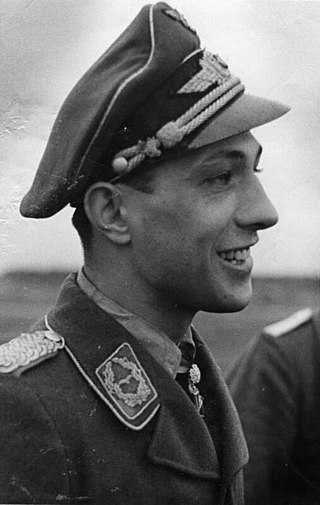
Erich Rudorffer was a German Luftwaffe fighter ace who was one of a handful who served with the Luftwaffe through the whole of World War II. He was one of the most successful fighter pilots in the history of air warfare, with 222 victories claimed. Rudorffer fought in all the major German theaters of war, including the European and Mediterranean Theater of Operations and the Eastern Front. During the war he flew more than 1000 combat missions, engaging in aerial combat over 300 times. Rudorffer was shot down by flak and enemy fighters 16 times and had to take to his parachute nine times.

Georg-Peter "Schorsch" Eder was a German Luftwaffe military aviator and fighter ace during World War II. He is credited with 78 aerial victories achieved in 572 combat missions, including 150 combat missions with the Messerschmitt Me 262 jet fighter. This figure includes 10 aerial victories on the Eastern Front, and further 68 victories over the Western Allies, including 36 four-engined bombers.
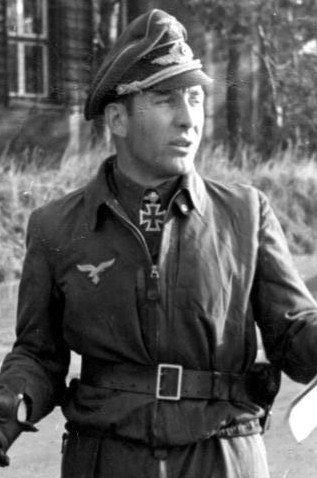
Theodor Weissenberger was a German Luftwaffe military aviator during World War II and a fighter ace credited with 208 enemy aircraft shot down in 375 combat missions. The majority of his victories were claimed near the Arctic Ocean in the northern sector of the Eastern Front, but he also claimed 33 victories over the Western Front. He claimed eight of these victories over the Western Allies while flying the Messerschmitt Me 262 jet fighter.
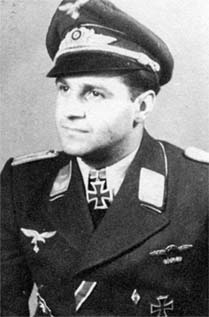
Franz Schall was a German military aviator who served in the Luftwaffe during World War II. As a fighter ace, he flew approximately 550 combat missions and claimed 137 aerial victories—that is, 137 aerial combat encounters resulting in the destruction of the enemy aircraft. He was also a recipient of the Knight's Cross of the Iron Cross, the highest award in the military and paramilitary forces of Nazi Germany during World War II.
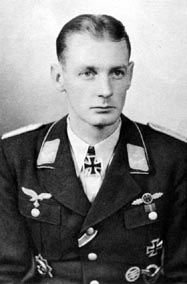
Rudolf "Rudi" Rademacher was a German military aviator who served in the Luftwaffe during World War II. As a fighter ace, he was credited with 97, potentially up to 126, aerial victories—that is, 97 aerial combat encounters resulting in the destruction of the enemy aircraft—claimed in over 500 combat missions. The majority of his victories were claimed over the Eastern Front, with sixteen claims over the Western Front, all of which were achieved while flying the Messerschmitt Me 262 jet fighter.
Erich Hohagen was a German general in the Bundeswehr. During World War II, he served as a fighter pilot in the Luftwaffe. A fighter ace, Hohagen was credited with 56 aerial victories and was a recipient of the Knight's Cross of the Iron Cross, the highest award in the military and paramilitary forces of Nazi Germany during World War II.
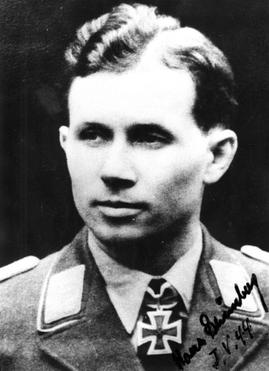
Hans "Specker" Grünberg was a German military aviator who served in the Luftwaffe during World War II. As a fighter ace, he was credited with 82, aerial victories—that is, 82 aerial combat encounters resulting in the destruction of the enemy aircraft—claimed in approximately 550 combat missions. The majority of his victories were claimed over the Eastern Front, with 21 claims over the Western Front, including five flying the Messerschmitt Me 262 jet fighter.
Heinz Arnold was a German Luftwaffe fighter ace. He is credited with 49 aerial victories including seven victories claimed flying the Messerschmitt Me 262 jet fighter.
An Erprobungskommando (EKdo) ("Testing-command") was a variety of Luftwaffe special-purpose unit tasked with the testing of new aircraft and weaponry under operational conditions. Similarly-named Erprobungs-prefixed squadron (staffel) and group (gruppe) sized units also existed at various times in the Luftwaffe during 1939-1944 to service-test new designs, usually numbered with the RLM aircraft designation system airframe number matching the aircraft they were meant to test, with the three digit number following the "8-xxx" RLM airframe number designating the unit, as with Erprobungsstaffel 177, charged with testing the A-0 production prototypes of the Heinkel He 177A heavy bomber. The similarly-prefixed Erprobungsgruppe 210 was meant to have service-tested the Messerschmitt Me 210 twin-engined "destroyer" and light bomber, but that design's early aerodynamic problems caused the unit's transformation and expansion into SKG 210, a dedicated "fast bomber" unit using Bf 110s instead.
Alfred Teumer was a German Luftwaffe military aviator and fighter ace during World War II. He is credited with 76 aerial victories claimed in over 300 combat missions. This figure includes 66 aerial victories on the Eastern Front, and further ten claims over the Western Allies.
Ludwig-Wilhelm "Lutz" Burckhardt was a Luftwaffe ace and recipient of the Knight's Cross of the Iron Cross during World War II. The Knight's Cross of the Iron Cross was awarded to recognise extreme battlefield bravery or successful military leadership. During his career, he was credited with 69 aerial victories, 16 on the Western Front and 53 on the Eastern Front.

Hans Dortenmann was a German Luftwaffe military aviator and fighter ace during World War II. He is credited with 39 aerial victories achieved in 150 combat missions. This figure includes 17 aerial victories on the Eastern Front and 22 over the Western Allies.
Herbert Kutscha was a German Luftwaffe fighter ace and recipient of the Knight's Cross of the Iron Cross during World War II. The Knight's Cross of the Iron Cross was awarded to recognise extreme battlefield bravery or successful military leadership. He was one of few Luftwaffe pilots to survive the whole war, serving from 1939 until 1945. During his career he was credited with 47 aerial victories in more than 900 missions.












